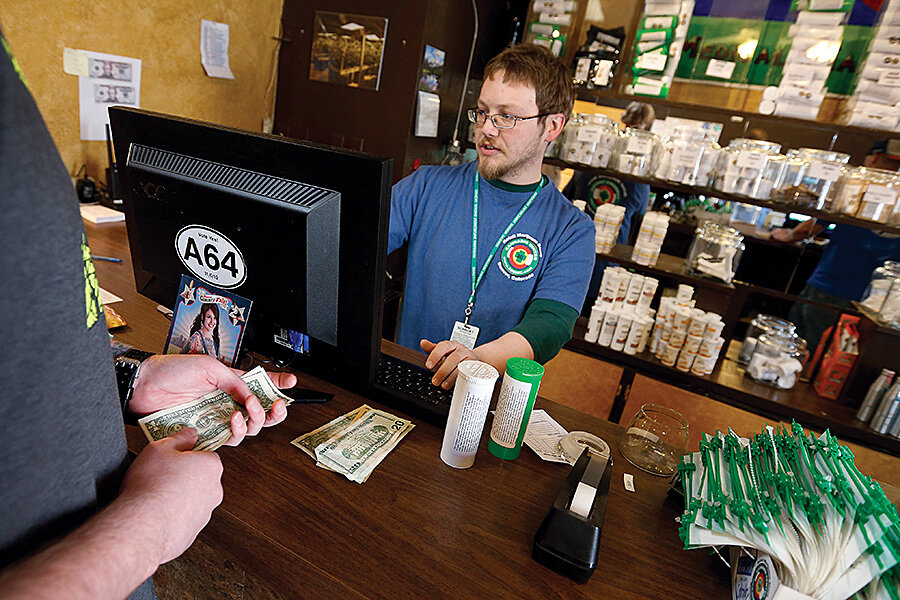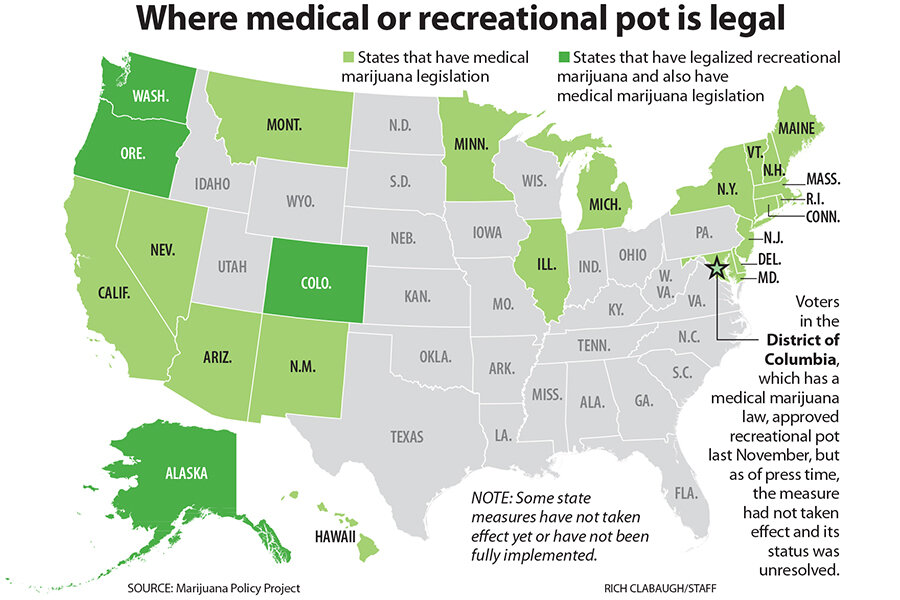Legal marijuana experiment in two states: Has it worked?
Loading...
| Boulder, Colo.
At the Options Medical Center in Boulder, a top local seller of recreational marijuana, a steady stream of customers ranging from men in their 20s to middle-aged professional women goes through the door to buy pot. Connor Dozois, the budtender on duty, fills orders for some regular customers who know exactly what they want, and he talks others through the differences in strains like “sour wookie” and “Kryptonite,” or how indica or sativa pot might each affect them, or the range of “edibles” available.
Just over a year after the first recreational pot shops opened in Colorado, “the sky is not falling,” says Options owner Greg Goldston, echoing a popular sentiment among legalization proponents in the state.
That premise may be correct – and most Coloradans will tell you they don’t notice much difference between the commercialized medical system that’s been in place in the state since 2009 and the new legalized recreational system. But there’s also a wide range of opinions about how successful America’s first foray into full marijuana legalization has been.
Actual data are still sparse, and will continue to be for several years. But both Colorado and Washington, the other state to begin legal recreational sales last year (albeit on a slower timetable than in Colorado), are under scrutiny as other states join them.
Some 23 states now have legal medical marijuana in place in some form, and last November, residents of Oregon, Alaska, and the District of Columbia voted to fully legalize pot. Legalization advocates say that 2016 is likely to be the next big year, when Arizona, California, Maine, Massachusetts, and Nevada (at a minimum) could all vote on legalization.
Moreover, a majority of Americans now support legalization, although the 51 percent who told Gallup they supported it last fall is down from the 58 percent who supported it a year ago.
The United States, overall, is experiencing a sea change in how it sees marijuana, and many observers see federal legalization as likely 10 or 15 years down the road. Colorado and Washington are the tip of the trend, and their experiences – both their successes and missteps – are likely to shape how legalization plays out as other states learn from their example.
“From a policy perspective, we won’t be able to say it’s a huge success or whether it’s a failure for quite some time because the data is so new,” says John Hudak, a governance studies fellow at the Brookings Institution in Washington, D.C., and author of a report on Colorado’s experience with legalization. “We do know it’s not an end-of-days disaster, and that allows us from a policy perspective to be a little more patient, to get more data so we can make an empirical assessment rather than a flippant assessment.”
Two sets of data sometimes cited in relation to Colorado’s experience were collected after legalization was voted on but before it took effect. A Colorado survey shows that teen marijuana use dropped from 22 percent in 2011 to 20 percent in 2013, although critics of legalization take issue with some of the methodology used.
The National Survey on Drug Use and Health, meanwhile, found that the share of Coloradans who use marijuana monthly jumped – from 10.4 percent to 12.7 percent – between 2012 and 2013, putting the state just behind Rhode Island as having the highest portions of regular pot users in the country.
“Since voters voted on this, we’ve seen increases on [use] according to the only representative data set out there on Colorado and Washington,” says Kevin Sabet, cofounder of the San Diego-based Smart Approaches to Marijuana (SAM), which opposes legalization.
In the Brookings report on Colorado’s experience, Mr. Hudak argues that Colorado is succeeding on at least one level: implementation. The state has met the various deadlines for setting up a regulatory framework, the industry and policymakers have worked well together, the rules lined up with the goals of the policy, and the overall rollout has gone smoothly – particularly impressive given that Gov. John Hickenlooper, a Democrat, was against legalization.
“Policymaking is hard work, sometimes even harder at the state level,” Hudak says. “Colorado was able to set up regulations that governed a market [and] made pretty informed choices about not only what the state and consumers would need, but also how to create a system that was responsive to the fact that this is a new policy area that is going to involve some learning.”
It was enormously helpful that Colorado already had a well-developed medical marijuana system, adds Hudak, who notes that Washington, which didn’t have a regulated system in place, has faced more challenges. He wonders how legalization might play out differently in a state that doesn’t have as functional a government.
The idea that so little data are available on legalization so far bothers Mr. Sabet of SAM. If it’s truly an experiment, he says, it should be proceeding more slowly.
“Right now, this is an exercise for the marijuana industry to make money,” he says. “My biggest concern is that we’re creating Big Tobacco 2.0, and we’re allowing them to market a drug that has a big risk for the developing brain to young people.”
Tom Gorman, director of the Rocky Mountain High Intensity Drug Trafficking Area, a Colorado-based task force that targets drug trafficking, also takes a negative view. He says that since legalization, he’s seen an increase in hospitalizations related to marijuana, in fatalities in which marijuana comes back on the toxicology report, and in the instances of marijuana being taken out of Colorado to other states.
A survey of 100 Colorado school resource officers in June indicated that 89 percent had seen an increase in student marijuana-related incidents since recreational marijuana was legalized.
“Preliminarily, it doesn’t look positive,” says Mr. Gorman. “If I were another state, I’d say, let’s wait until we get a couple more years of data and then make a decision on the facts and figures, and not on rhetoric.”
One theory behind legalization is that it would reduce – or even all but eliminate – the black market. There’s some evidence in Colorado that the black market is dwindling, but it’s been more of a problem in Washington, where supply was initially limited, taxes are high, and the legal price has been considerably higher than the black market price.
“That’s a crucial lesson for other places: You can’t have it both ways. There has to be relatively easy access to avoid a black market,” says Jeffrey Miron, a Harvard lecturer and director of economic studies at the libertarian Cato Institute who has studied legalization in Colorado and Washington.
In a working paper on the effects in Colorado, Mr. Miron has found relatively few impacts – either negative or positive – so far. He adds that in past examples of drug decriminalization or moves toward legalization for which more data are available, the dramatic negatives predicted by opponents haven’t come to pass. “Unless you can show some fairly bad effects of giving people more freedom, you should give them more freedom,” Miron says.
As legalization progresses, though, some worry that eventually the price will drop too far and the rates of heavy use might increase.
“As long as commercial prices are above medical, there’s very little to learn about the consequences,” says Mark Kleiman, a professor of public policy at the University of California at Los Angeles. Dr. Kleiman supports legalization in theory, but worries that the way it’s being done so far in both Washington and Colorado is too industry-driven, without sufficient controls on the sort of widespread use that might occur when prices come down.
A system modeled on the liquor boards in most states – which do little to prevent the effects of alcohol abuse – isn’t what states should be going for on marijuana, Kleiman says.
States “can’t learn much from [Colorado and Washington] because the bad stuff hasn’t started yet,” he says. “In the long run, both Colorado and Washington will discover their taxes are way too low.... I think we’re getting locked into a system that will be hard to get out of.”
Mr. Goldston, at the Boulder store, dismisses such concerns, saying what he sees is users gravitating toward higher-quality product if they can afford it rather than using significantly more.
“You look at Portugal, the Netherlands – people don’t just start using it because it’s available,” he says.
Most legalization proponents agree that the current forays haven’t been perfect, but say that creating a legal industry from scratch is a complicated process that, to be successful, is going to need to adapt as it goes – much the way Colorado has shifted when it comes to edibles (see “The unexpected problems of food laced with pot”).
“There’s going to be a certain amount of experimentation at the local and state level, and lessons learned over a period of time,” says Stephen Gutwillig, deputy executive director of programs at the Drug Policy Alliance, a proponent of legalization based in New York.
California, where Mr. Gutwillig has been active in the push for a 2016 ballot measure, will have its own set of challenges, he says, since its medical marijuana system is both large and almost completely unregulated.
If legalization is passed in Massachusetts and Maine, it will be the first time it moves out of the West, he notes, and Arizona will test its possibility in a very red state.
Ultimately, he and others say they think Congress will be pushed into voting for legalization at some point in the not-too-
distant future. “An intolerable dissonance is emerging between state and federal policy,” Gutwillig says. “Something’s got to give, and it’s going to be federal prohibition.”







